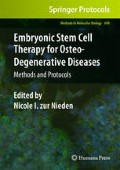Abstract
Advances in stem therapy, scaffolds, and therapeutic biomolecules are accelerating bone repair research, and model systems are required to test new methods and concepts. The drill hole defect is one such model and is used to study a variety of bone defects and potential therapies designed to repair these injuries. We detail the methodologies required to successfully generate and evaluate drill hole defects. Although performing a successful drill hole defect requires patience and dexterity, investing the time to perfect the technique will provide ample opportunity for the researcher to expand his/her particular research interests. Mastering this technique will allow testing of stem cell therapies, novel scaffold designs, and biomolecules that can be used for clinical translation.
Access this chapter
Tax calculation will be finalised at checkout
Purchases are for personal use only
References
Kumar, S., and Ponnazhagan, S. (2007) Bone homing of mesenchymal stem cells by ectopic alpha 4 integrin expression. FASEB J. 21, 3917–3927.
Lee, S.W., Padmanabhan, P., Ray, P., Gambhir, S.S., Doyle, T., Contag, C., et al. (2009) Stem cell-mediated accelerated bone healing observed with in vivo molecular and small animal imaging technologies in a model of skeletal injury. J Orthop Res. 27(3), 295–302.
Hayashi, O., Katsube, Y., Hirose, M., Ohgushi, H., and Ito, H. (2008) Comparison of osteogenic ability of rat mesenchymal stem cells from bone marrow, periosteum, and adipose tissue. Calcif Tissue Int . 82(3), 238–247.
Chang, S.C., Chuang, H., Chen, Y.R., Yang, L.C., Chen, J.K., Mardini, S., et al. (2004) Cranial repair using BMP-2 gene engineered bone marrow stromal cells. J Surg Res. 119(1), 85–91.
Cui, L., Liu, B., Liu, G., Zhang, W., Cen, L., Sun, J., et al. (2007) Repair of cranial bone defects with adipose derived stem cells and coral scaffold in a canine model. Biomaterials. 28(36), 5477–5486.
Centeno, C.J., Busse, D., Kisiday, J., Keohan, C., Freeman, M., and Karli, D. (2008) Increased knee cartilage volume in degenerative joint disease using percutaneously implanted, autologous mesenchymal stem cells. Pain Physician. 11(3), 343–353.
Bikram, M., Fouletier-Dilling, C., Hipp, J.A., Gannon, F., Davis, A.R., Olmsted-Davis, E.A., et al. (2007) Endochondral bone formation from hydrogel carriers loaded with BMP2-transduced cells. Ann Biomed Eng. 35(5), 796–807.
Ge, Z., Tian, X., Heng, B.C., Fan, V., Yeo, J.F., and Cao, T. (2009) Histological evaluation of osteogenesis of 3D-printed poly-lactic-co-glycolic acid (PLGA) scaffolds in a rabbit model. Biomed Mater. 4(2), 21001.
Petersen, W,. Zelle, S., and Zantop, T. (2008) Arthroscopic implantation of a three dimensional scaffold for autologous chondrocyte transplantation. Arch Orthop Trauma Surg. 128(5), 505–508.
Williams, J.M., Adewunmi, A., Schek, R.M., Flanagan, C.L., Krebsbach, P.H., Feinberg, S.E., et al. (2005) Bone tissue engineering using polycaprolactone scaffolds fabricated via selective laser sintering. Biomaterials. 26(23), 4817–4827.
Claase, M.B., de Bruijn, J.D., Grijpma, D.W., and Feijen, J. (2007) Ectopic bone formation in cell-seeded poly(ethylene oxide)/poly(butylene terephthalate) copolymer scaffolds of varying porosity. J Mater Sci Mater Med. 18(7), 1299–1307.
Krupa, P., Krsek, P., Javornik, M., Dostál, O., Srnec, R., Usvald, D., et al. (2007) Use of 3D geometry modeling of osteochondrosis-like iatrogenic lesions as a template for press-and-fit scaffold seeded with mesenchymal stem cells. Physiol Res. 56(Suppl 1), S107–S114.
Weinand, C., Pomerantseva, I., Neville, C.M., Gupta, R., Weinberg, E., Madisch, I., et al. (2006) Hydrogel-beta-TCP scaffolds and stem cells for tissue engineering bone. Bone. 38(4), 555–563.
Bolland, B.J., Kanczler, J.M., Dunlop, D.G., and Oreffo, R.O. (2008) Development of in vivo muCT evaluation of neovascularisation in tissue engineered bone constructs. Bone. 43(1), 195–202.
Park, C.H., Abramson, Z.R., Taba, M. Jr., Jin, Q., Chang, J., Kreider, J.M., et al. (2007) Three-dimensional micro-computed tomographic imaging of alveolar bone in experimental bone loss or repair. J Periodontol. 78(2), 273–281.
Datir, A.P. (2007) Stress-related bone injuries with emphasis on MRI. Clin Radiol. 62(9), 828–836.
Ecklund, K., Vajapeyam, S., Feldman, H.A., Buzney, C.D., Mulkern, R.V., Kleinman, P.K., et al. (2010) Bone marrow changes in adolescent girls with anorexia nervosa. J Bone Miner Res. 25(2), 298–304.
Ehrhart, N., Kraft, S., Conover, D., Rosier, R.N., and Schwarz, E.M. (2008) Quantification of massive allograft healing with dynamic contrast enhanced-MRI and cone beam-CT: a pilot study. Clin Orthop Relat Res. 466(8), 1897–1904.
Moinnes, J.J., Vidula, N., Halim, N., and Othman, S.F. (2006) Ultrasound accelerated bone tissue engineering monitored with magnetic resonance microscopy. Conf Proc IEEE Eng Med Biol Soc. 1, 484–488.
Love, Z., Wang, F., Dennis, J., Awadallah, A., Salem, N., Lin, Y., et al. (2007) Imaging of mesenchymal stem cell transplant by bioluminescence and PET. J Nucl Med. 48(12), 2011–2020.
Pereira, A.C., Fernandes, R.G., Carvalho, Y.R., Balducci, I., Faig-Leite, H. (2007) Bone healing in drill hole defects in spontaneously hypertensive male and female rats’ femurs. A histological and histometric study. Arq Bras Cardiol. 88(1), 104–109.
Katae, Y., Tanaka, S., Sakai, A., Nagashima, M., Hirasawa, H., and Nakamura, T. (2009) Elcatonin injections suppress systemic bone resorption without affecting cortical bone regeneration after drill-hole injuries in mice. J Orthop Res. 27(12), 1652–1658.
Nagashima, M., Sakai, A., Uchida, S., Tanaka, S., Tanaka, M., and Nakamura, T. (2005) Bisphosphonate (YM529) delays the repair of cortical bone defect after drill-hole injury by reducing terminal differentiation of osteoblasts in the mouse femur. Bone. 36(3), 502–511.
Obenaus, A., and Smith, A. (2004) Radiation dose in rodent tissues during micro-CT Imaging. J X-Ray Sci Technol. 12, 241–249.
Willey, J.S., Grilly, L.G., Howard, S.H., Pecaut, M.J., Obenaus, A., Gridley, D.S., et al. (2008) Bone architectural and structural properties after 56Fe26+ radiation-induced changes in body mass. Radiat Res. 170(2), 201–207.
Author information
Authors and Affiliations
Corresponding author
Editor information
Editors and Affiliations
Rights and permissions
Copyright information
© 2011 Springer Science+Business Media, LLC
About this protocol
Cite this protocol
Obenaus, A., Hayes, P. (2011). Drill Hole Defects: Induction, Imaging, and Analysis in the Rodent. In: Nieden, N. (eds) Embryonic Stem Cell Therapy for Osteo-Degenerative Diseases. Methods in Molecular Biology, vol 690. Humana Press. https://doi.org/10.1007/978-1-60761-962-8_20
Download citation
DOI: https://doi.org/10.1007/978-1-60761-962-8_20
Published:
Publisher Name: Humana Press
Print ISBN: 978-1-60761-961-1
Online ISBN: 978-1-60761-962-8
eBook Packages: Springer Protocols

